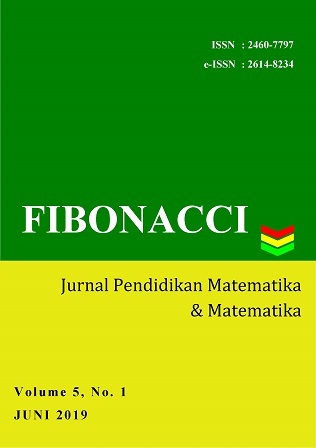REPRESENTASI VISUAL MATEMATIS MAHASISWA DALAM MEMODELKAN KEJADIAN DINAMIS DITINJAU DARI PERBEDAAN GAYA KOGNITIF DAN JENIS KELAMIN
Main Article Content
Abstract
Article Details
Authors who publish with this journal agree to the following terms:
- Authors retain copyright and grant the journal right of first publication with the work simultaneously licensed under a Creative Commons Attribution License that allows others to share the work with an acknowledgement of the work's authorship and initial publication in this journal.
- Authors are able to enter into separate, additional contractual arrangements for the non-exclusive distribution of the journal's published version of the work (e.g., post it to an institutional repository or publish it in a book), with an acknowledgement of its initial publication in this journal.
- Authors are permitted and encouraged to post their work online (e.g., in institutional repositories or on their website) prior to and during the submission process, as it can lead to productive exchanges, as well as earlier and greater citation of published work (See The Effect of Open Access).
References
An, D., & Carr, M. 2017. "Learning Styles Theory Fails to Explain Learning and Achievement: Recommendations for Alternative Approaches". Personality and Individual Differences, Vol. 116, pp: 410–416.
Arcavi, A. 2003. "The Role of Visual Representations in the Learning of Mathematics". Educational Studies in Mathematics. Vol. 52 (3), pp: 215–241.
Boonen, A. J. H., Van Wesel, F., Jolles, J., & Van der Schoot, M. 2014. "The Role of Visual Representation Type, Spatial Ability, and Reading Comprehension in Word Problem Solving: An Item-Level Analysis in Elementary School Children". International Journal of Educational Research. Vol. 68, pp: 15–26.
Carlson, M. P., Jacobs, S., Coe, E., Larsen, S., & Hsu, E. 2002. "Applying Covariational Reasoning While Modeling Dynamic Events: A Framework and A Study". Journal for Research in Mathematics Education. Vol. 33 (5), pp: 352–378.
Castillo-Garsow, C., Johnson, H. L., & Moore, K. C. 2013. "Chunky and Smooth Images of Change". For the Learning of Mathematics. Vol. 33 (3), pp: 31–37.
David, M. M., Tomaz, V. S., & Ferreira, M. C. C. 2014. "How Visual Representations Participate in Algebra Classes’ Mathematical Activity". ZDM Mathematics Education. Vol. 46 (1), pp: 95–107.
Fennema, E., Carpenter, T. P., Jacobs, V. R., Franke, M. L., & Levi, L. W. 1998. "A Longitudinal Study of Gender Differences in Young Children’s Mathematical Thinking". Educational Researcher. Vol. 27 (5), pp: 6–11.
Gallager, A. M., & De Lisi, R. 1994. "Gender Difference in Scholastic Aptitude Test- Mathematics Problems Solving Among High School Students". Journal for Research in Mathematics Education. Vol. 86 (2), pp: 204–211.
Haciomeroglu, E. S., & Chicken, E. 2012. "Visual Thinking and Gender Differences in High School Calculus". International Journal of Mathematical Education in Science and Technology. Vol. 43 (3), pp: 303–313.
Haciomeroglu, E. S., Chicken, E., & Dixon, J. K. 2013. "Relationships Between Gender, Cognitive Ability, Preference, and Calculus Performance". Mathematical Thinking and Learning. Vol. 15 (3), pp: 175–189.
Lemke, J. L. 2002. "Mathematics in The Middle: Measure, Picture, Gesture, Sign, and Word. In M. Anderson, A. Saenz-Ludlow, S. Zellweger, & V. Cifarelli (Eds.)". Educational Perspectives on Mathematics as Semiosis: From Thinking to Interpreting to Knowing. Ottawa: Legas Publishing, pp: 215–234.
Lipovec, A., & Antolin, D. 2015. "Schematic and Pictorial Representations of Exponentiation. In O. Fleischmann, R. Seebauer, H. Zoglowek, & M. Aleksandrovich (Eds.)". The Teaching Profession. LIT Verlag Münster, pp. 137–144.
Miftah, R., & Orlando, A. R. 2016. "Penggunaan Graphic Organizer dalam Meningkatkan Kemampuan Representasi Matematis Siswa". FIBONACCI: Jurnal Pendidikan Matematika dan Matematika. Vol. 2 2, pp: 72–89.
NCTM. 2002. Principles and standards for school mathematics. Reston V.A: NCTM.
Oh, E., & Lim, D. 2005. "Cross Relationships Between Cognitive Styles and Learner Variables in Online Learning Environment". Journal of Interactive Online Learning. Vol. 4 (1), pp: 53–66.
Snowman, J., McCown, R., & Biehler, R. 2012. Social Cognitive Theory. Psychology Applied to Teaching (13th ed.). Belmont, CA: Wadsworth, Cengage Learning.
Subanji. 2011. Teori Berpikir Pseudo Penalaran Kovariasi. Malang: UM Press.
Tall, D. 2009. "Dynamic Mathematics and The Blending of Knowledge Structures in The Calculus". ZDM – The International Journal on Mathematics Education. Vol. 41 (4), pp: 481 – 492.
Thompson, P. W., & Carlson, M. P. 2017. "Variation, Covariation, and Functions: Foundational Ways of Thinking Mathematically. In J. Cai (Ed.), Compendium for Research in Mathematics Education. Reston, VA: Compendium for research in mathematics education, pp. 421–456.
Ulfatin, N. 2017. Metode Penelitian Kualitatif di Bidang Pendidikan: Teori dan Aplikasinya. Malang: Media Nusa Creative.
Umah, U., As’ari, A. R., & Sulandra, I. M. 2014. Penalaran Kovariasional Siswa Kelas VIIIB MTS Negeri Kediri 1 dalam Mengkonstruk Grafik Fungsi. Thesis. Malang: Universitas Negeri Malang.
Witkin, H. A., Moore, C. A., Goodenough, D. R., & Patricia W. Cox. 1977. "Field-Dependent and Field-Independent Cognitive Styles and Their Educational Implications". Review of Educational Research. Vol. 47 (1), pp: 1–64.
Yung, H. I., & Paas, F. 2015. "Effects of Computer-Based Visual Representation on Mathematics Learning and Cognitive Load". Educational Technology and Society. Vol. 18 (4), pp: 70–77.
Zhang, L.-F., & Sternberg, R. J. 2009. Perspectives on the nature of intellectual styles. New York: Springer.

